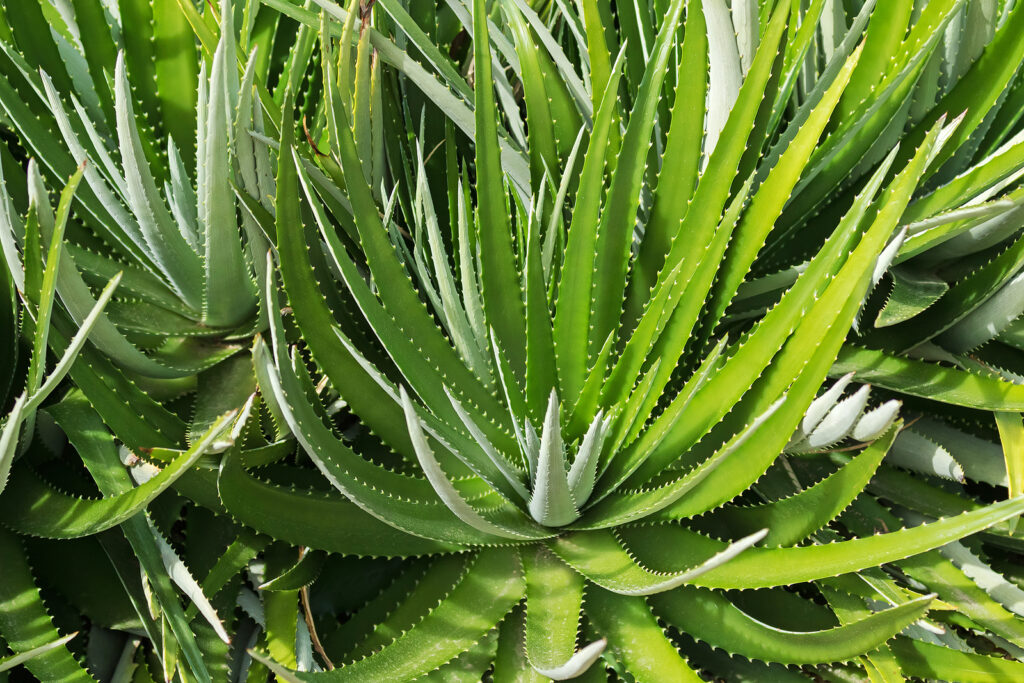Dyckia is a terrestrial bromeliad with silvery-gray and occasionally reddish-brown spike-toothed leaves and thorny tips. The leaves are borne in rosettes. Orange flowers appear atop slender stems in spring.
Dyckia is often grown as a houseplant, but it grows well in tropical and subtropical gardens and in desert gardens where temperatures are not cold in winter. Dyckia must be grown in full sun in well-drained gritty, humus-rich soil.
Dyckia is a genus of evergreen succulent bromeliads native to South America.
Get to know Dyckia
- Plant type: Terrestrial bromeliad
- Growing zones and range: Zones 13-15
- Optimal growing temperature: day, 68°F (20°C) and up in summer, somewhat cooler in winter; night, 60° to 65°F (16° to 18°C).
- Height and width: 8 to 32 inches (20-80cm) tall, 5 to 16 inches (13-40cm) wide depending on the variety.
- Foliage: Linear to lance-shaped or short, triangular, spiny-margined, stiff, often gray-scaly leaves; spiny leaves form rosettes up to 16 inches (41 cm) across.
- Flowers: Tubular yellow to orange flowers; bears 15 to 20 waxy flowers on 12- to 24-inch (30 to 61cm) stalks.
- Bloom time: Summer
- Uses: Houseplant, tropical garden, desert garden
- Common name: Miniature Agave, sawblade plant
- Botanical name: Dyckia
- Family name: Bromeliaceae
- Origin: South America

Where to plant Dyckia
- Light indoors: Give Dyckia full sun from southern exposure. Air circulation is important.
- Light outdoors: Grow Dyckia in full sun.
- Soil indoors: Grow Dyckia in a terrestrial bromeliad mix.
- Soil outdoors: Sharly drained, gritty, humus-rick soil
When to plant Dyckia
- Set Dyckia outdoors in a tropical or subtropical climate any time during the year.
Planting and spacing Dyckia
- Space Dyckia 5 to 16 inches (13-40cm) apart depending on the variety.
How to water and feed Dyckia
- Water: Water Dyckia moderately from latre spring to autumn. Keep the soil barely moist, allowing soil to dry moderately between waterings. Humidity, 35% or less.
- Feeding: Feed Dyckia monthly, with mild liquid fertilizer. Avoid oil-based products such as fish emulsion. Apply to soil after watering; never fertilize a dry plant.
Dyckia care
- Dyckia growth slows in winter. Reduce water and frequency of feeding. Keep the plant in a cool place.
Dyckia pests and diseases
- Check Dyckia for scale insects.
Dyckia propagation
- Divide Dyckia clumps in late spring or early summer. Replant offsets
- Dyckia can be grown form seed in warm soil in early spring.
Dyckia varieties to grow
- Dyckia brevifolia, sawblade plant. Glossy, dark green leaves with sharp spines; bright orange flowers.
- D. fosteriana. Grows 8 inches (20cm) tall and 5 inches (13cm) wide; flat rosettes of silver-gray leaves; bright orange flowers in late spring.
- D. platphylla. Grows to 32 inches (80cm) tall and 16 inches (40m) wide; dark green leaves with white scaled on undersides; bears bright yellow flowers in late spring.
- D. remotiflora. Dense rosettes of narrow triangular leaves covered with gray-green scales; dark orange flowers in late spring.















